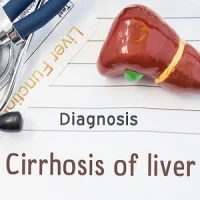Cirrhosis, a major worldwide health problem, has a high level of morbidity and mortality. Patients with cirrhosis who require intensive care support have high mortality rates of near 50 percent. This patient population presents numerous challenges to the intensive care provider but, unfortunately, current management strategies remain largely guided by expert opinion, according to an article published online in the journal Current Treatment Options in Gastroenterology.
"Recent epidemiological studies have shown an increase in hospitalisations due to advanced liver disease with an associated increase in intensive care utilisation. Given an increasing burden on the healthcare system, it is imperative that we strive to improve our management cirrhotic patients in the intensive care unit," says article author Jody C. Olson, MD, University of Kansas Medical Center in Kansas City.
Cirrhosis of the liver is a progressive disease in the vast majority of cases. Cirrhosis is a heterogeneous disorder that represents a spectrum of illness ranging from asymptomatic disease to true “end-stage” disease that without transplantation results in death.
Neurological dysfunction in critically ill cirrhotic patients is largely due to hepatic encephalopathy (HE), according to the article. HE is largely a clinical diagnosis and may be made on the basis of a detailed neurological examination combined with thorough review of patient’s history. Common findings are alterations in attention, impaired performance of addition or subtraction, confusion, gross disorientation, and coma.
"The first priority in treatment of HE is assuring the patient has adequate airway protection; for patients with advanced HE and a Glasgow Coma Score of ≤ 8 intubation should be considered," says Dr. Olson. "The next priority is aimed at identifying and correcting precipitating events; this includes a careful assessment for potential infections such as spontaneous bacterial peritonitis (SBP), urinary tract infections, and Clostridium difficile colitis."
Specific therapies for treating HE include ammonia-lowering agents such as the disaccharide lactulose or polyethylene glycol solution. In the outpatient setting, lactulose is titrated to achieve 2–3 soft bowel movements daily, the author explains.
Other common complications of cirrhosis include haemostatic abnormalities, acute variceal haemorrhage of oesophageal or gastric varices, and renal dysfunction. When patients are actively bleeding, correction of platelet count to 50 K/μL is appropriate as thrombin generation is normal when platelet counts are above this level. Endoscopic therapy is the preferred intervention for acute oesophageal variceal haemorrhage.
Given the complex nature of decision making in advanced liver disease in the ICU, the author stresses that this patient population benefits from multidisciplinary care coordinated among experts in critical care, hepatology, liver transplantation, and palliative care.
"Large studies evaluating the management of patients in the intensive care setting are lacking. To date, most recommendations are based on extrapolation of data from studies in cirrhosis outside of the ICU or by applying general critical care principles which may or may not be appropriate for the critically ill cirrhotic patient. Future research is required to answer important management questions," the article concludes.
Source: Current Treatment Options in Gastroenterology
Image Credit: Creative Commons
References:
Olson JC (2018) Intensive Care Management of Patients with Cirrhosis. Curr Treat Options Gastro. Published online 04 April 2018. DOI: 10.1007/s11938-018-0182-2.
Latest Articles
intensive care, cirrhosis, cirrhotic patients
Cirrhosis, a major worldwide health problem, has a high level of morbidity and mortality. Patients with cirrhosis who require intensive care support have high mortality rates of near 50 percent. This patient population presents numerous challenges to the










